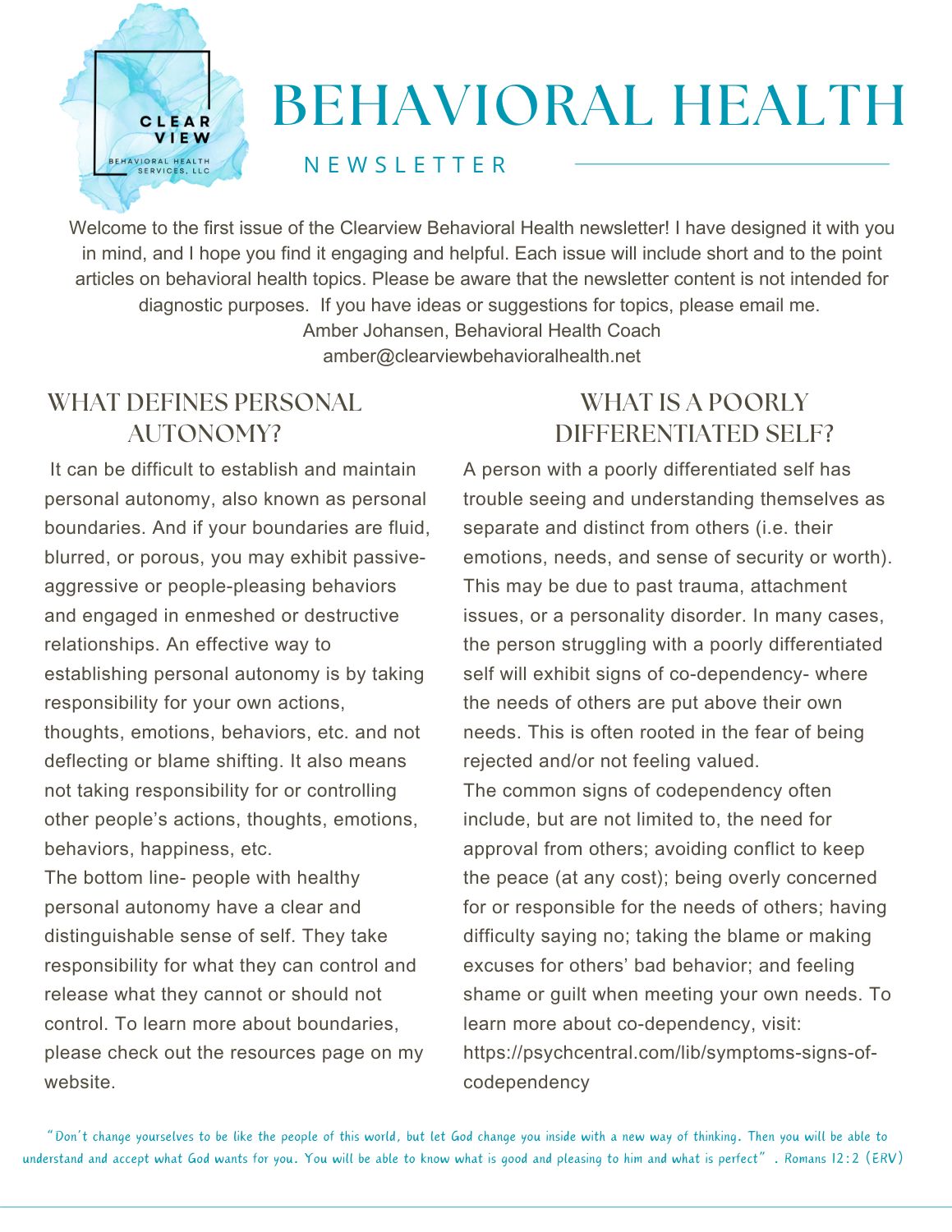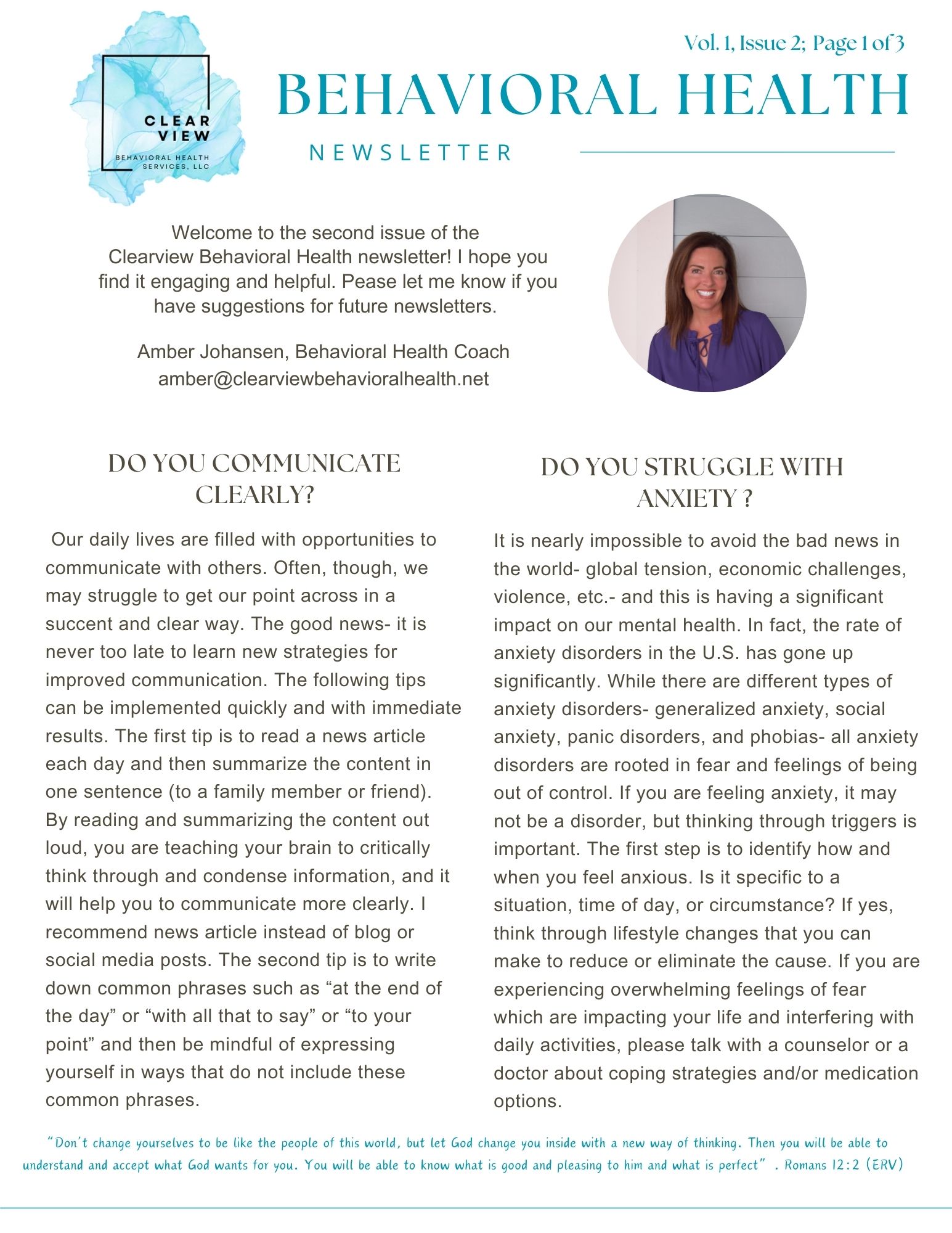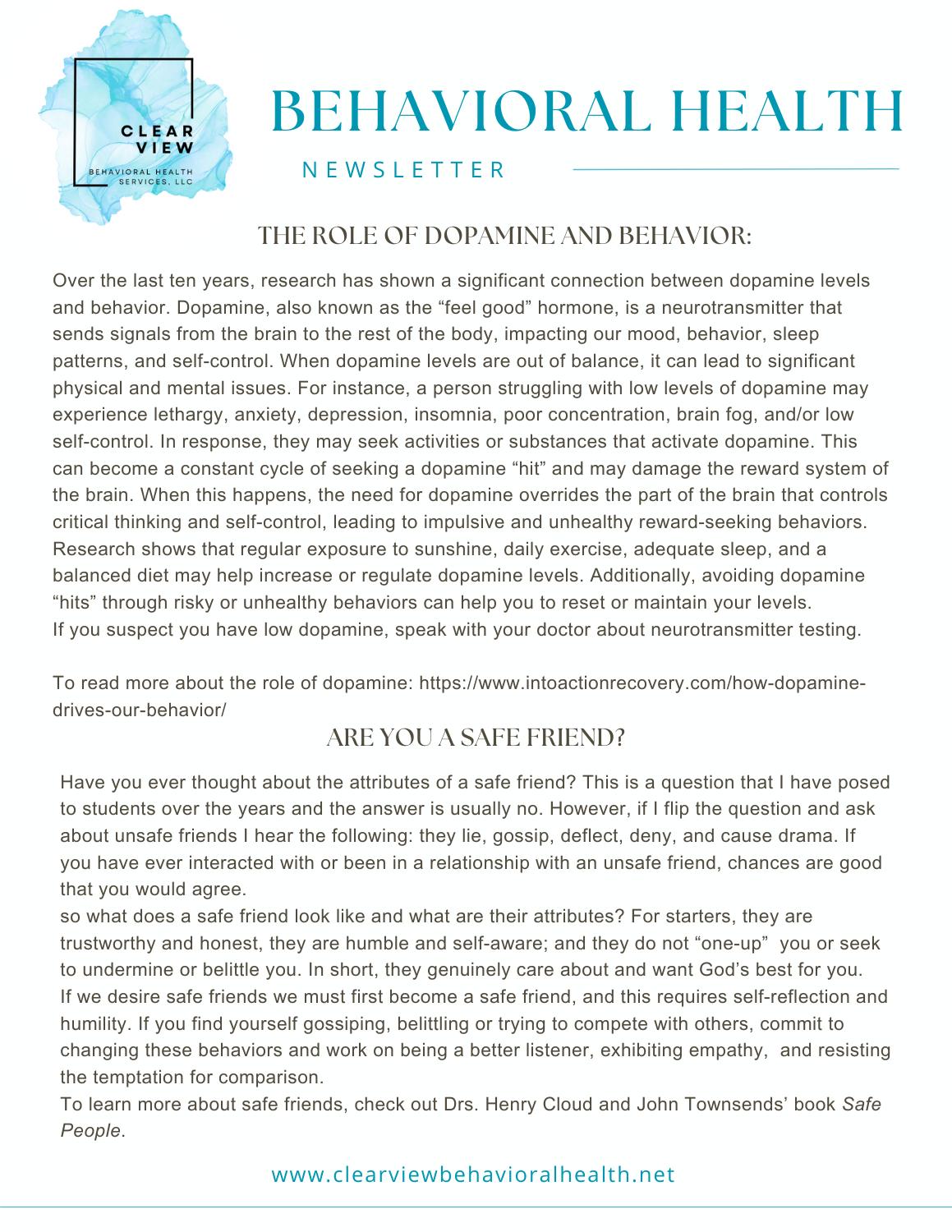
Blog Posts for improving your life
how to offer support in a time of crisis or suffering
By Amber Johansen

Helping a loved one in crisis can be difficult, and finding the right words may cause us to unintentionally distance ourselves emotionally or say the wrong thing. With that in mind, I’m offering a few suggestions for responding in a supportive and helpful way. Keep in mind that these are general guidelines and may not apply to every situation. However, they can help you express empathy, consideration, and encouragement in a healthy, constructive way.
Defining a Crisis
A crisis is a state of instability or danger that leads to a significant change or emotional upheaval. It is usually triggered by unforeseen events like health issues, accidents, death, or natural disasters, and is marked by fear, instability, and change.
Understanding Empathy
Empathy is the ability to understand and share someone else's feelings by imagining yourself in their situation. When we empathize, we offer meaningful support. Without empathy, we risk being less considerate or, worse, adding to the pain the person is already feeling.
How to Enter Someone's Experience
A good example of empathy can be seen in the story of Job from the Old Testament. Job loses everything—his children, property, possessions, and health. His friends come to comfort him:
"Now when Job’s three friends heard of all this adversity that had come upon him, each one came from his own place; for they had made an appointment together to come sympathize with him and to comfort him. When they looked from a distance and did not recognize him because of his disfigurement, they raised their voices and wept; and each one tore his robe in grief and threw dust over their heads in sorrow. So they sat down on the ground with Job for seven days and seven nights, and no one spoke a word to him, for they saw that his pain was very great." —Job 11:13
From this, we can learn three key things about empathy:
They Go to Him: Love is an action. Job’s friends showed their love by being physically present. While this isn't always possible, we can still "be there" through phone calls, texts, or emails.
They Enter His Grief and Sorrow: Job's friends acknowledged both his physical pain and his emotional suffering. Today, we can do this by offering a simple hug or saying, "I’m so sorry this has happened" or "My heart is breaking for you."
They Sit With Him in Silence: Job’s friends didn’t try to offer advice or look on the bright side. Instead, they sat with him, understanding that there were no words that could help at that moment. We can offer similar support by being present, listening, and checking in, showing patience, love, and compassion.
As the story of Job unfolds, his friends begin questioning the circumstances of his suffering and become unsupportive, critical, and argumentative. In fact, Job refers to them as "miserable comforter". With this in mind, let's talk about how to encourage and support others in constructive ways.
How to Offer Encouragement and Support Constructively
Recognize Your Limits Concerning Negative Emotions: If you struggle with processing negative emotions, it’s okay to communicate this to your friend without making it about you. You can say, “I care deeply about you, and I’m really sorry for what you’re going through. I sometimes struggle with processing tough emotions, but I want to be here for you in any way I can.”
Maintain Healthy Boundaries: It’s important not to own their experience. While it might feel natural to offer solutions or observations, be sure to ask for permission: “May I offer a suggestion?” or “Can I share an observation?” If the answer is no, respect it.
Avoid Toxic Positivity: Comments like “It could be worse” or “Everything happens for a reason” can be incredibly harmful. Also, avoid sharing personal stories that shift the focus away from their pain. The goal is to acknowledge their feelings, not dismiss or minimize them.
Remain Patient: In long-term suffering, we may experience compassion fatigue. It’s important to be self-aware, set boundaries, and seek support when needed to avoid burnout. A trusted friend or counselor can help you navigate these emotions.
Be an Encouragement: During a crisis, people often feel helpless and hopeless. While it’s important to sit with them in their suffering, you also need to be aware if they become stuck in self-pity. Offer encouragement by saying, “I can imagine you’re feeling overwhelmed. How can I support you?” This keeps the conversation empathetic while gently offering a path forward.
In closing, my purpose in writing this is to encourage you (and myself) to push through the uncomfortable self-doubt that comes with supporting others in their suffering and to offer a few suggestions on how to navigate these difficult experiences. The bottom line is to extend love by offering words of encouragement, compassion, hope.
This is an excerpt of a text. It was sent to someone who is fighting cancer by one of her closest friends. It's a wonderful example of speaking life and hope into a scary and exhausting circumstances:
I am in awe of your strength and ability to stay focused on [God] sustaining you through these beyond difficult stretches of your journey. You are truly an amazing warrior...I see [God's] strength being made perfect in your weakness...I know you are feeling weary, but I see strength. Know that I am praying for your spirit as much as your physical needs.
Hi Friends, I am happy to recommend the following products. Since I have allergies and sensitive skin, I rotate products, read labels, and check affordability. I have used or currently use all of these products and highly recommend them, and they may be purchased on Amazon by clicking the corresponding links.
Vitamins
Probiotic- I take a variety of probiotics, including this brand (I take 2 of these a day). Culturelle Daily Probiotic Gummies
Vitamin B complex- I take one of these daily. It includes all vitamin Bs that are needed for memory, sleep, skin, etc. Vitamin B Complex
Multi-Vitamin- Pure Multi-Vitamin
Cosmetics and Skin Care
Lipstick- I love this lip color stick and have it in multiple colors. Neutrogena MoistureSmooth Color Stick for Lips
Hydrating Serum - I use this on my face and in my hair. Hydrating Serum for Face
Eyelid cleanser- This product works great for itchy, burning eyelids. TheraTears Eyelid Cleanser
Face cream- I use this product at different times of the day, not just at night. It's not sticky and very hydrating. No.7 Night Cream
Dry brushing brushes- These are great for dry skin and lymphatic stimulation. Dry Brushing Body Brush
Face primer- This is a great, affordable product that I use in place of make up. No.7 Foundation Primer
Bronzer- I love this product...it smells great and looks natural. HAN Skincare Cosmetics, Cruelty-Free Bronzer
Face and body cream- This product is not thick or sticky. I highly recommend all Simple products. Simple Water Boost Skin Quench Cream
Face sunblock- Great light SPF that isn't sticky. Simple Kind to Skin Protecting Light Moisturiser SPF 15
Other Items
Vibration plate- We are obsessed with this item and use it twice a day. It helps with lymphatic drainage, back and joint pain, blood pressure, allergies, etc. . Vibration Plate Exercise Machine
Ear protection- My daughter is sensitive uses these often and highly recommends them. Hearing Protection for Concerts & Festivals
Mold blocker- Mold growth is dangerous for your health. I have used this product on water damaged areas and my patio. Mold Blocker Spray
Work chair- I recently purchased this chair for my work office and I love it so much! Armless Office Desk Chair
Pain relief-This product is a roll on and has no odor. It's the absolute best for neck, back, feet pain. Aspercreme Lidocaine Pain Relief Roll-On
Mold testing kit- This product is incredible.
Low noise dog clippers/shaver: I use these on our Goldendoodle a lot! The box includes shaver, guards, clippers, etc. Dog Shaver Clipper
Paw trimmers: I also use these on our Goldendoodle to trim his paws...he tolerates it pretty well. Dog Paw Trimmer
Salmon oil- A drop or two on your dog's food will go a long way. It's great for their skin, allergies, and digestion. Wild Alaskan Salmon Oil for Dogs
Dog bed: We've purchased a lot of dog beds over the years...this one's the best, easy to clean, and very affordable. Dog Bed for Medium Large Dogs
Eye treatment: We've used this on both of our dogs for eye infections. All Animal Eye Wash, Helps Relieve Pink Eye & Allergy Symptoms
Ear treatment: Our Goldendoodle had terrible smelling ears, nothing seemed to help but this. It's awesome! Medicated Ear Drops for Dogs and Cats
Books
Whether you are twenty-five or fifty-five, chances are you have been in a situation or relationship where you have exhibited immature emotional responses. This may be due to inadequate response skills, an inability to reflect and replace, or stunted emotional growth. Many of us were not taught appropriate conflict resolution skills or had parents who modeled poor or destructive behaviors. However, this does not mean we are stuck in the same response cycles with no opportunity to change.
Sometimes, our immature emotional responses are triggered by a hurt, fear, or threat perceived during the interaction, causing us to go into fight, flight, freeze, or fawn mode. These responses may impact your marriage, children, aging parents, siblings, or co-workers and building skills for healthier responses may vastly improve these relationships.
Let’s explore unhealthy patterns of behavior, the causes, and ways to grow emotionally. Note that these steps are general suggestions for awareness, reflection, and growth and are not designed for diagnosing or treating emotional patterns related to mental illness, addiction, or abuse. If you are experiencing any of these, please seek help immediately.
The first step, is to identify the behaviors-especially repeated patterns- so that you can replace them with healthier responses. The following are examples of immature responses:
1. Emotional manipulation- Pouting, sulking, and the silent treatment.
2. Reactive responses- Ranting, lashing out, aggression, name-calling.
3. Poor impulse control- Quick escalation of emotions.
4. Lack of responsibility- Deflecting, blaming, and gaslighting.
1. Lack of conflict resolution skills-Growing up in a family where you were not allowed to experience negative emotions, express your likes and dislikes, or differentiate from your parent’s values.
2. Past trauma- Experiencing trauma in childhood may result in emotional stunting, and regression patterns.
3. Hurt, fear, threat- Perceiving situations or experiences as hurtful, scary, or threatening (real or otherwise).
1. Reflect- Think about and write down past and recent patterns of responses in situations where you felt hurt, fear, or threat; determine if there are patterns in the interactions and responses.
2. Name the patterns- Use the four patterns of behaviors listed above as references (include responses that may not be listed).
3. Acknowledge- Take responsibility for these behaviors while also having compassion and patience for yourself.
4. Talk with a trusted person- Ask them for feedback on your reflections and patterns.
5. Integrate-Consider alternative behaviors to be integrated into your response patterns.
6. Reframe and replace-This step may take time to implement. It involves taking responsibility, reducing impulsivity, remaining reflective, and considering alternate responses.
If you are responding from a place of trauma or lack of conflict resolution skills, this step is critical for emotional maturity. These skills require practice and build on each other as you work to integrate new patterns of responding.
Example Scenario: Discussing finances with your spouse.
Reflect: Notice unhealthy patterns of response when you have these conversations.
Name the patterns: Quick escalation of emotions, ranting, and lashing out.
Acknowledge- Accept these patterns of behaviors and consider alternative responses.
Talk: Discuss your responses with a trusted friend or counselor.
Integrate: Plan for how to respond and set boundaries before the discussion.
Reframe and replace: Reframe the conversation as one where you and your spouse work together for solutions. Discuss possible triggers and replace threatening or hurtful language with supportive and instructive language.
1. Pause: Take a moment before responding.
2. Consider: Think about the circumstances, the other person’s perspective, and response options.
3. Respond: Be aware of your tone and body language. Communicate if you need a break before responding.
4. Reflect: Think about how you responded and consider integrating this behavior in other circumstances
5. Revise: If you revert back to an old pattern, extend grace to yourself, apologize and respond appropriately.
“I hear what you are saying and it’s important to me, but I need a few minutes to calm down/process/consider how to respond appropriately. I appreciate your patience with me.”
“I am sorry for how I responded earlier. I was feeling (hurt, afraid, threatened) because I felt (give reason). Please give me an opportunity to revise my response.”
These steps are suggestions for improving your response to conflict and are not exhaustive. They aim to promote self-awareness, self-ownership, and a willingness to improve interactions with others. If you have trouble with these exercises or experience anxiety or depression during the process, please consider seek help from a counselor, pastor, or therapist.
Additional resource on emotional maturity: https://www.verywellmind.com/signs-of-emotional-maturity-7553316
To read Amber's parenting blog, please click here


